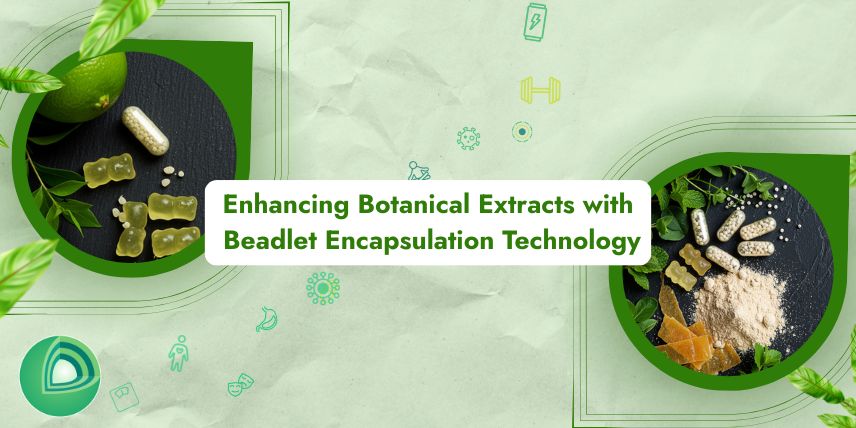
Ancient botanical knowledge and cutting-edge delivery technologies are becoming increasingly combined in the nutraceutical and wellness sectors. For centuries, traditional medical systems such as Ayurveda, Traditional Chinese Medicine (TCM), and Western Herbalism have relied heavily on botanical extracts derived from herbs, roots, flowers, and other plant parts. However, it has not been simple to make them bioavailable, stable, and effective in today's formulations.
A novel delivery method that makes it possible to formulate traditional botanicals into contemporary forms is beadlet encapsulation. Natural extracts are stabilised and protected by this novel technique, which transforms them into highly useful components for a variety of uses, including functional foods and beverages and dietary supplements.
Why Use Botanical Extracts?
The bioactive substances found in botanicals, such as polyphenols, flavonoids, alkaloids, and terpenes, are highly valued for their numerous health advantages. From ginsenosides in ginseng for energy and vitality to curcumin in turmeric for inflammation, botanicals have a strong reputation thanks to scientific validation and consumer trust.
However, a lot of botanical extracts have drawbacks:
Low stability or solubility
Light, heat, and oxygen sensitivity
A bad taste or smell
Low gastrointestinal tract bioavailability
When it comes to formats like gummies, effervescent tablets, clear beverages, or chewable capsules, these difficulties become important.
Encapsulation Technology: A Contemporary Approach
These barriers can be successfully eliminated with encapsulation solutions. Botanical extracts are embedded in protective matrices using sophisticated encapsulation techniques, frequently involving food-grade polymers, starches, or gums. Consequently, beadlets-tiny, spherical, freely flowing particles-are created.
Benefits of Encapsulated Botanical Beadlets:
Defence Against Degradation
Protected from oxidation, UV light, and moisture, sensitive phytochemicals have a longer shelf life and greater potency.
Targeted or Controlled Release
To improve therapeutic results, beadlets can be made to release in particular parts of the gastrointestinal tract, like the intestine, rather than the stomach.
Enhanced Compressibility and Flow
The use of beadlets in the production of tablets and capsules is improved by their dry, consistent shape.
Visual Appeal and Branding
Adding visual appeal to transparent capsules, powdered blends, or beauty-from-within formulations is made possible by coloured or dual-layer beadlets.
Common Encapsulated Botanicals
Numerous botanical active ingredients have been effectively added to beadlet form factors. Among the noteworthy ones are:
Curcumin (extract from turmeric)
Curcumin is well-known for destroying free radicals and lowering inflammation, but it is also infamously unstable and poorly absorbed. Its solubility and protection are improved by beadlet technology.
Extract from Green Tea (EGCG)
Although green tea catechins are oxidisable, they maintain their antioxidant activity for an extended period within beadlets.
Adaptogenic extracts of ashwagandha (Withania somnifera) can be encapsulated for regulated delivery, which lessens bitterness and enhances the user experience.
Extracts of Ginseng
Beadlet matrices stabilise and release the active ingredients, ginsenosides, gradually.
Resveratrol
Beadlets significantly increase the stability of a strong antioxidant that becomes unstable when exposed to light and oxygen.
Applications in Different Segments
When used as beadlets, botanical ingredients are extremely versatile and have benefits across various industries.
Nutraceuticals: Strong herbal actives with improved bioavailability can now be found in softgels, chewables, tablets, and capsules.
Functional Foods and Drinks
When stability and taste masking are crucial, beadlets work well in clear beverages, powdered blends, protein shakes, and even baked goods.
Sports Nutrition: Pre-workout or recovery formulas can incorporate herbal supplements, such as cordyceps or ginseng, with release times modified appropriately.
Personalisation: The Upcoming Development
In addition to improving delivery, modern encapsulation allows formulation customization. You can personalize botanical beaded bracelets by
Key components (one or more active ingredients)
Profiles of releases (immediate, delayed, or sustained)
Customizable color
Addition of additives
Distribution of particle sizes
Such customization lets brands and producers craft distinct products for particular health issues or lifestyles. Umang Global Group specializes in encapsulation technology, providing an encapsulation solution to improve the product quality of your brand, making you more assured and relaxed. From aloe vera extract beadlets, Amla extract beadlets, Chamomile extract beadlets, Curcuma longa extract beadlets, to Green tea extract beadlets, Peppermint extract beadlets, Red clover extract beadlets, Saffron extract beadlets, Shilajit extract beadlets, Spirulina extract beadlets, and many more, catering to your requirements.
Sustainability and Clean Label Considerations
Consumers today expect more than just efficacy-they expect transparency, safety, and environmental stewardship. Botanical beadlets support clean label claims by using:
Natural colorants and plant-based polymer layering
Non-GMO, vegan encapsulation materials
Environmentally friendly processing techniques
This resonates with a wellness-focused, ethically-minded consumer base.
Conclusion: Tradition Reinvented
Combining traditional knowledge and modern encapsulation science is changing the delivery of herb-based health solutions. Beadlet encapsulation makes stability, bioavailability, and formulation flexibility accessible to deliver quality, high-performance wellness products.
As consumers embrace plant power and anticipate new delivery formats, botanical beadlets lie at the confluence of ancient healing and modern science - true innovation born from tradition.
Contact us to order an encapsulated product sample today!! And get ready to shine.

